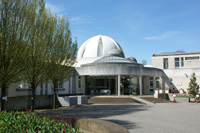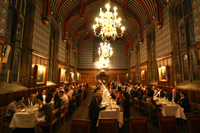 Archive
Archive
3rd International Materials Education Symposium, 2011
The world's largest event focused on undergraduate materials teaching across engineering, science, and design
Cambridge University,
April 5-6, 2011
125 people from 26 countries gathered in Cambridge for the 3rd International Materials Education Symposium. This year, the Symposium was coordinated by Granta Design, with support from an Academic Advisory Committee, ASM International, the ASEE Materials Division, SEFI, FEMS, TMS, and the Department of Materials Science and Metallurgy at the University of Cambridge. The majority of participants stayed on-campus at Murray Edwards College (pictured, right). This provided many opportunities for networking and discussion, complementing the formal presentations and social program. An atmosphere of collaboration and encouragement was firmly established on the Wednesday evening, when many of the speakers and presenters joined a candle-lit dinner in the 16th century charm of Magdalene College's Hall. On Thursday, discussions from the first day spilled over into the evening in the historic Corpus Christi college (founded in 1352). With the glorious sunshine continuing into the weekend, the Symposium concluded with punting along the River Cam on Saturday. |
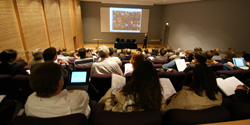 |
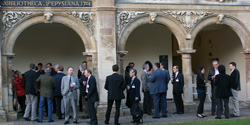 |
|||
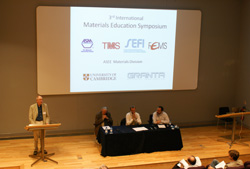 Symposium Report
Symposium Report
The four sessions of the Symposium provided an excellent forum for discussion and sharing of ideas, covering all aspects of materials education. Opening talks were given by Peter Goodhew, Erik de Graaff, Mike Ashby, and Yves Bréchet, who also joined the session chairs (Bill Clyne, Alexander Wanner, David Embury, and Sybrand van der Zwaag) in leading the discussions which brought each session to a close.
Session One: 'Inspiring first years; maintaining inspiration into the second year and beyond'.
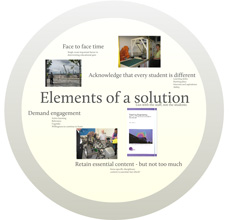 The speakers in the opening session certainly inspired the audience, presenting with enthusiasm and demonstrating a range of creative approaches to materials teaching. Having acknowledged the challenges of increasing class size, and the variety in students' learning styles and indeed ability, ideas were shared on how to encourage students to be pro-active in their learning from the very beginning. In particular, we saw examples from Andy Horsewell of deconstruction and reporting on the materials and processes used in high-tech products. Similarly, Tom Joyce talked about the benefits of hands on experience and competitive small-group project work. Such approaches are engaging students while teaching them the skills of professional engineers and materials scientists.
The speakers in the opening session certainly inspired the audience, presenting with enthusiasm and demonstrating a range of creative approaches to materials teaching. Having acknowledged the challenges of increasing class size, and the variety in students' learning styles and indeed ability, ideas were shared on how to encourage students to be pro-active in their learning from the very beginning. In particular, we saw examples from Andy Horsewell of deconstruction and reporting on the materials and processes used in high-tech products. Similarly, Tom Joyce talked about the benefits of hands on experience and competitive small-group project work. Such approaches are engaging students while teaching them the skills of professional engineers and materials scientists.
The morning session discussion provided opportunities to find out more about the different methodologies presented. Useful tips included how to source interesting materials for deconstruction, and the merits of involving higher year students with the projects, for example, analyzing the metallurgy. Many participants emphasized the need for students to take responsibility for their own learning—making it clear from day one that they should come to each session prepared. Various ideas were shared in how to encourage this attitude with students of different abilities.
Session Two: Using information technology in materials teaching
Information technology has plenty to offer modern materials education—and many universities are making full use of technologies including 'Blackboard', 'Moodle' and wikis to provide course material and even assessments. In some instances, as both Frederic Veer and Mark Jolly revealed, traditional lectures have been entirely replaced by online material. In these instances, labs, practical classes, and plenary sessions provide the essential face-to-face contact with students. Pirjo Pietikainen told us how her university is consolidating lectures into a few days each month, combining courses with neighboring institutions, and inviting leading experts from industry and academia. Online and small group teaching is then successfully driving enthusiasm and learning between lectures.
![]() However, it was clear that the new IT approaches cannot always be seen as 'time saving'. Instead they can help maximise the impact of available resources. This is especially true of resource sharing though Open Educational Resources (OER) such as those provided by projects such as CoreMaterials, DoITPoMS, and Granta's Teaching Resources Website.
However, it was clear that the new IT approaches cannot always be seen as 'time saving'. Instead they can help maximise the impact of available resources. This is especially true of resource sharing though Open Educational Resources (OER) such as those provided by projects such as CoreMaterials, DoITPoMS, and Granta's Teaching Resources Website.
The afternoon discussion covered a range of topics, including how to scale teaching to larger and larger class-sizes, and what role IT had in that, with particular discussion on the topic of online assessments. Emphasis was placed on using IT to help students attain the 'adjacent possible'—increasing their learning from where they are as individuals.
Strong feelings about accreditation started the lively concluding discussion session on day one. This then broadened out to assess the benefits of internships in providing both a real-world anchor for learning and an increased professionalism in the attitude of students. The demonstrable successes of Problem Based Learning and shared online resources were balanced by concerns (in the UK at least) about the effects of increasing fees, and more generally about maintaining individualized teaching with increasing class sizes.
Session Three: Interdisciplinary materials teaching and service-taught courses: "Materials and the Environment", a cross-disciplinary topic
 Materials science, as Mike Ashby argued in his opening talk for this session, is a bridging discipline (see figure, right), linking the pure and applied sciences across many fields. As such, it is often a key element in interdisciplinary teaching. John Dunlop provided examples of some of the challenges involved for a material scientist 'learning a new language' in order to communicate properly in fields such as biomaterials, as well as the many advantages which both disciplines see once this barrier has been overcome. The difficulties don't just go one-way: non materials specialists often have to teach a component of material science as part of their courses too.
Materials science, as Mike Ashby argued in his opening talk for this session, is a bridging discipline (see figure, right), linking the pure and applied sciences across many fields. As such, it is often a key element in interdisciplinary teaching. John Dunlop provided examples of some of the challenges involved for a material scientist 'learning a new language' in order to communicate properly in fields such as biomaterials, as well as the many advantages which both disciplines see once this barrier has been overcome. The difficulties don't just go one-way: non materials specialists often have to teach a component of material science as part of their courses too.
There was particular emphasis on 'materials and the environment', with a range of examples of the introduction of new environmental topics into undergraduate programs. Both Jose Miguel Atienza and Plato Kapranos were both helpfully open in discussing how they have evolved their courses. In both cases, students are quickly discovering that this is no 'soft-option', but that engagement with the issues surrounding sustainability requires a solid grounding in mathematics and material properties. Thus this session concluded with Rob Wallach's enthusiastic call for 'Material Science to Save the World'—not least by equipping students to apply the necessary rigour whatever they go on to do in their professional lives.
The session discussion again allowed Symposium participants to share ideas and resources. This was particularly appreciated by non materials specialists present. Mike Ashby raised the question of whether sustainability, like ethics, ought to infuse everything we do, and if so, how should it best be taught? The importance of being able to rapidly assess environmental impact of engineering products in the early-stages of design was repeatedly raised, both in Bruno de Benedetti's presentation and throughout the discussion.
Session Four: Design, materials selection, and industry.
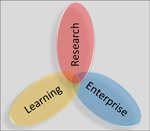 The final session turned to design, materials selection, and industry. We heard many examples (such as from Yves Bréchet, Hengfeng Zuo, Dag Holmgren, and Salem Seifeddine), of how students have benefited from close involvement with industry—giving them real-world problems to solve and preparing them for their professional lives in engineering, industrial design, and many other areas. One of the most important ways that we can equip them for this, argued Erik Templelman, is to teach them how to distinguish what is (im)possible in principle from what is (im)possible in practice.
The final session turned to design, materials selection, and industry. We heard many examples (such as from Yves Bréchet, Hengfeng Zuo, Dag Holmgren, and Salem Seifeddine), of how students have benefited from close involvement with industry—giving them real-world problems to solve and preparing them for their professional lives in engineering, industrial design, and many other areas. One of the most important ways that we can equip them for this, argued Erik Templelman, is to teach them how to distinguish what is (im)possible in principle from what is (im)possible in practice.
In the concluding discussion session, this theme was continued with an emphasis on equipping students for a process of Life Long Learning, and on-going interaction between academia and industry. We heard experiences from participants around the world about different attitudes to Life Long Learning, and discussed how academics can best support industry. At this international conference, the issue of material producers moving East was raised: we discussed how best to support the diffusion of technology and manufacturing ability, but also the social responsibility which means we should not be exporting the associated problems. As these fruitful discussions drew to a close, Dave Embury thanked Mike Ashby and the Symposium organizers for the "intellectual stimulation provided yet again to the community"—a sentiment widely shared by all the participants—as well as for the support of ASM International, the ASEE Materials Division, SEFI, FEMS, TMS, and the Department of Materials Science and Metallurgy, University of Cambridge .
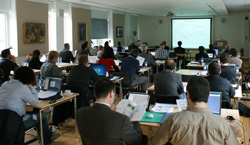 Posters and Courses
Posters and Courses
Alongside the main Symposium talks, the two-day poster session was well attended. Together with the many discussion sessions and the social program, this helped encourage networking and the sense of community that enveloped the entire event. Further support to the materials education community was provided by Mike Ashby, who led short courses in the use of CES EduPack on the two days preceding the symposium.
Looking forward to 2012!
This year's International Materials Education Symposium and short courses provided an excellent venue for a supportive exchange of ideas from those involved in materials education around the world. The range of topics and openness of the discussions meant that many left with a renewed enthusiasm and plenty of practical tips to support their teaching. Feedback from the event was extremely encouraging: there is definitely a need for this kind of collaborative event in materials education. Indeed, several participants commented that the Symposium was probably the largest and most revelant event focussed on undergraduate materials education in the past five years,
In light of this, the Symposia's Academic Advisory Committee is now starting to draw together the key themes and topics for the 4th International Materials Education Symposium. This will again take place at the University of Cambridge, on April 12-13. In the meantime, we would like to thank all those whose presentations and contributions made this such an interactive and collaborative event.

